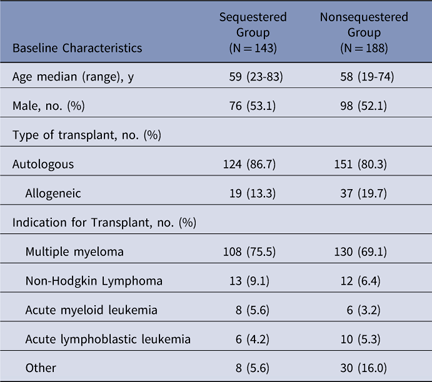To the Editor—Inpatient bone marrow transplant (BMT) requires long hospitalization on the order of weeks to months. During this time, hematopoietic stem cell transplant (HSCT) recipients are at risk for disease- and treatment-related complications, and neutropenic infections are a significant cause of morbidity and mortality. Long hospitalizations are burdensome to patients, both physically and mentally, and remaining sedentary leads to physical deconditioning that often necessitates physical rehabilitation either during hospitalization or after discharge.Reference Hayes, Davies, Parker, Bashford and Green 1 Additionally, the decreased quality of life and stress during the transplant hospitalization has been associated with the development of depression and posttraumatic stress disorder (PTSD).Reference El-Jawahri, Vandusen and Traeger 2
Practice guidelines for antibiotic prophylaxis and treatment of neutropenic infections are well-established.Reference Freifeld, Bow and Sepkowitz 3 Although there are guidelines for nonpharmacologic infection prevention measures, there is little evidence to support a standard of care, and practices vary by institution. Commonly accepted practices include single-occupant rooms with HEPA filtration systems, strict hand hygiene, and the avoidance of fresh fruits, vegetables and plants etc.Reference Tomblyn, Chiller and Einsele 4 Recent literature has also suggested that surgical masks for all persons in contact with neutropenic patients can reduce the incidence of viral respiratory infections (VRIs).Reference Sokol, De La Vega-Diaz and Edmondson-Martin 5 Although it is a common policy for patients to be under strict isolation precautions during periods of prolonged neutropenia, there remains insufficient evidence to support this practice.Reference Hayes-Lattin, Leis and Maziarz 6
Prior to October 2016, neutropenic patients were sequestered in private rooms on the BMT unit at our institution. During routine review, physical therapists noted that sequestered patients were overly sedentary and susceptible to physical deconditioning during this time. In response to these concerns, the Bone Marrow Transplant Quality Assurance Committee lifted the sequestration order, allowing neutropenic patients on the BMT unit to leave their rooms if they maintained strict handwashing and surgical mask precautions. We hypothesized that this change in policy would reduce both the need for physical therapy (PT) and hospital length of stay (LOS), as well as improve overall patient satisfaction. These benefits were believed to outweigh the theoretical increased risk of infection associated with leaving an isolated environment.
We reviewed 143 records of sequentially admitted patients before the neutropenic policy before the neutropenic policy change from February 2016 through September 2016 and 188 records after the policy was changed from October 2016 through June 2017. The inclusion criterion was admission to the BMT unit for autologous or allogeneic stem cell transplant, regardless of indication.
Hospital LOS and overall PT requirements were recorded. PT requirements were determined based upon a physical therapist’s recommendation and included acute rehabilitation, subacute rehabilitation, or home PT. The frequency of PT consultation was also recorded. The total number of documented hospital-acquired VRIs, as diagnosed by a comprehensive viral panel polymerase chain reaction (PCR), was recorded in each study group. Viral respiratory infections were diagnosed as hospital-acquired infections retrospectively if patients were asymptomatic on admission, and PCR was confirmed after the estimated incubation period of the virus. 7 – 10
Baseline characteristics are summarized in Table 1. The average hospital LOS was 19.00 days in the sequestered group and was 19.31 days in the nonsequestered group (2-proportion z test, z=.74; P=.46). There were 50 PT consults in the sequestered group and 53 consults in the nonsequestered group (2-proportion z test, z=1.32; P=.19). Physical therapy was recommended for 19 patients in the sequestered group and 34 patients in the nonsequestered group (2-proportion z test, z =.99; P=.32). During the study period, 1 VRI occurred in the sequestered group and 3 occurred in the nonsequestered group (2-proportion z test, z=.74; P=.46). We recorded 1 case of each of the following VRIs: influenza A, respiratory syncytial virus (RSV), metapneumovirus, and parainfluenza 3.
Table 1 Baseline Characteristics

There is insufficient evidence to support the common practice of patient sequestration during post-HSCT neutropenia. While sequestration, in theory, reduces infection risk, it is potentially harmful because it may exacerbate physical deconditioning and cause psychological distress. Our findings do not support our original hypothesis that lifting the strict neutropenic isolation policy would decrease PT requirements and hospital LOS. A possible explanation for this finding is the inability to verify that the nonsequestered patients did, in fact, ambulate outside of their rooms. Given the well-known risk of infection associated with HSCT, many patients may have elected to stay in their rooms out of fear of acquiring an infection. Additionally, the degree of physical deconditioning associated with BMT patients and the benefit of ambulating around the unit versus ambulating in the hospital room may have been overestimated.
Although we observed was no difference in PT requirements and hospital LOS, we also observed no significant difference in incidence of VRIs between the 2 groups. Notably, the sequestration policy changed in October, so the nonsequestered group was studied over more winter months, when the overall incidence of VRIs is higher. Although the study population and incidence of VRI was small, these data suggest that the risk of acquiring a VRI during neutropenia by leaving an isolated room may be small and may potentially be outweighed by the benefits, namely, the psychological benefits of leaving confinement. A future study with a large sample size could better assess this risk and could focus on the psychological implications of sequestration and the benefits of ambulation outside of the hospital room.
In conclusions, more lenient neutropenic isolation precautions were not associated with decreased PT requirements or hospital LOS but were also not associated with an increased rate of hospital-acquired VRIs.
Acknowledgments
Financial support
No financial support was provided relevant to this article.
Conflicts of interest
All authors report no conflicts of interest relevant to this article.



